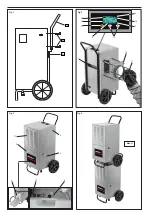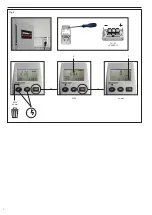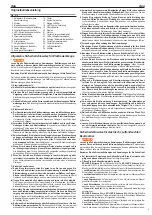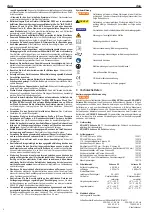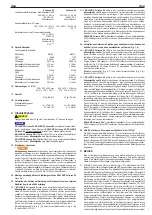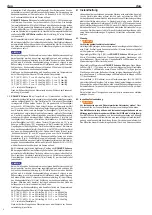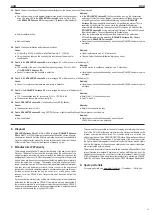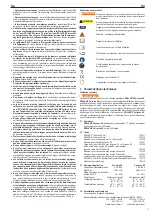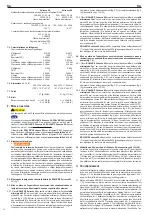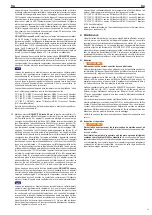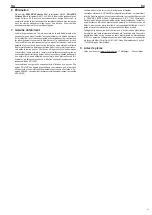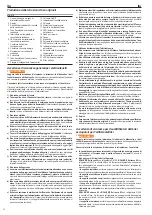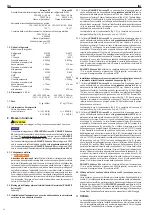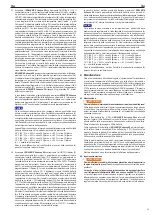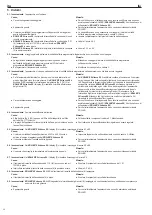
eng eng
Translation of the Original Instruction Manual
General power tool safety warnings
WARNING
WARNING
Read all safety warnings, instructions, illustrations and specifications provided
with this power tool. Failure to follow all instructions listed below may result in
electric shock, fire and/or serious injury.
Save all warnings and instructions for future reference.
The term “power tool” in the warnings refers to your mains-operated (corded) power
tool or battery-operated (cordless) power tool.
1) Work area safety
a) Keep work area clean and well lit. Cluttered or dark areas invite accidents.
b) Do not operate power tools in explosive atmospheres, such as in the pres-
ence of flammable liquids, gases or dust. Power tools create sparks which
may ignite the dust or fumes.
c) Keep children and bystanders away while operating a power tool. Distractions
can cause you to lose control.
2) Electrical safety
a) Power tool plugs must match the outlet. Never modify the plug in any
way. Do not use any adapter plugs with earthed (grounded) power tools.
Unmodified plugs and matching outlets will reduce risk of electric shock.
b) Avoid body contact with earthed or grounded surfaces, such as pipes,
radiators, ranges and refrigerators. There is an increased risk of electric shock
if your body is earthed or grounded.
c) Do not expose power tools to rain or wet conditions. Water entering a power
tool will increase the risk of electric shock.
d) Do not abuse the cord. Never use the cord for carrying, pulling or unplug-
ging the power tool. Keep cord away from heat, oil, sharp edges or moving
parts. Damaged or entangled cords increase the risk of electric shock.
e) When operating a power tool outdoors, use an extension cord suitable for
outdoor use. Use of a cord suitable for outdoor use reduces the risk of electric
shock.
f) If operating a power tool in a damp location is unavoidable, use a residual
current device (RCD) protected supply. Use of an RCD reduces the risk of
electric shock.
3) Personal safety
a) Stay alert, watch what you are doing and use common sense when oper-
ating a power tool. Do not use a power tool while you are tired or under
the influence of drugs, alcohol or medication. A moment of inattention while
operating power tools may result in serious personal injury.
b) Use personal protective equipment. Always wear eye protection. Protective
equipment such as a dust mask, non-skid safety shoes, hard hat or hearing
protection used for appropriate conditions will reduce personal injuries.
c) Prevent unintentional starting. Ensure the switch is in the off-position before
connecting to power source and/or battery pack, picking up or carrying the
tool. Carrying power tools with your finger on the switch or energising power
tools that have the switch on invites accidents.
d) Remove any adjusting key or wrench before turning the power tool on. A
wrench or a key left attached to a rotating part of the power tool may result in
personal injury.
e) Do not overreach. Keep proper footing and balance at all times. This enables
better control of the power tool in unexpected situations.
f) Dress properly. Do not wear loose clothing or jewellery. Keep your hair and
clothing away from moving parts. Loose clothes, jewellery or long hair can be
caught in moving parts.
g) If devices are provided for the connection of dust extraction and collection
facilities, ensure these are connected and properly used. Use of dust collection
can reduce dust-related hazards.
h) Do not let familiarity gained from frequent use of tools allow you to become
complacent and ignore tool safety principles. A careless action can cause
severe injury within a fraction of a second.
4) Power tool use and care
a) Do not force the power tool. Use the correct power tool for your application.
The correct power tool will do the job better and safer at the rate for which it was
designed.
b) Do not use the power tool if the switch does not turn it on and off. Any power
tool that cannot be controlled with the switch is dangerous and must be repaired.
c) Disconnect the plug from the power source and/or remove the battery pack,
if detachable, from the power tool before making any adjustments, changing
accessories, or storing power tools. Such preventive safety measures reduce
the risk of starting the power tool accidentally.
d) Store idle power tools out of the reach of children and do not allow persons
unfamiliar with the power tool or these instructions to operate the power
tool. Power tools are dangerous in the hands of untrained users.
e) Maintain power tools and accessories. Check for misalignment or binding
of moving parts, breakage of parts and any other condition that may affect
the power tool’s operation. If damaged, have the power tool repaired before
use. Many accidents are caused by poorly maintained power tools.
f) Keep cutting tools sharp and clean. Properly maintained cutting tools with
sharp cutting edges are less likely to bind and are easier to control.
g) Use the power tool, accessories and tool bits etc. in accordance with these
instructions, taking into account the working conditions and the work to be
performed. Use of the power tool for operations different from those intended
could result in a hazardous situation.
h) Keep handles and grasping surfaces dry, clean and free from oil and grease.
Slippery handles and grasping surfaces do not allow for safe handling and control
of the tool in unexpected situations.
5) Service
a) Have your power tool serviced by a qualified repair person using only
identical replacement parts. This will ensure that the safety of the power tool
is maintained.
Safety tips for electric air humidifier/building drier
WARNING
WARNING
with this power tool. Failure to follow all instructions listed below may result in
electric shock, fire and/or serious injury.
Save all warnings and instructions for future reference.
● In case of thermal decomposition of the refrigerant, (e.g. fire) highly noxious
and corrosive vapours are generated! There is a risk of intoxication.
● Never open up the refrigerant circuit.
ROLLER’S Scirocco 50 with R-410A refrigerant, ROLLER’S Scirocco 80 with
R-407C refrigerant in a closed circuit. Should refrigerant leak out in the event of
defective apparatus (e.g. breakage of a refrigerant hose, then the following must
be taken into consideration:
– After inhaling: Get those affected into the fresh air and let them rest. Use
artificial respiration if breathing stops. Call a physician.
– After contact with the skin: Thaw out or wash off affected portions of skin
with warm water.
– After contact with the eyes: Rinse out thoroughly for 10 minutes with clean
water. Call a physician.
– After swallowing: Do not induce regurgitation. Wash out mount with water,
drink a glass of water. Call a physician.
Notice for physician: Do not administer any drugs of the Ephedrine/adrenalin
group.
ROLLER’S Scirocco 50 and ROLLER’S Scirocco 80 with R-290 refrigerant in
a closed circuit. Should refrigerant leak out in the event of defective apparatus
(e.g. breakage of a refrigerant hose, then the following must be taken into
consideration:
– After inhaling: Get the victim into the fresh air and into a stable resting position.
Use artificial respiration if breathing stops. Call a physician.
– After contact with the skin: Rinse off affected parts of the body with luke
warm water for at least 15 minutes. Do not remove frozen clothing. Consult a
physician.
– After contact with the eyes: Protect the uninjured eye and wash out the
affected eye thoroughly with water. Remove any contact lenses if possible.
Consult a physician immediately.
– Notices for the physician / possible symptoms: Treat breathing difficulties,
unconsciousness symptomatically, monitor the cardiovascular system.
● Operate/store the device with R-290 refrigerant only in adequately ventilated
rooms with the permissible minimum size of 9 m
2
for ROLLER’S Scirocco
50 and 14 m
2
for ROLLER’S Scirocco 80, and without permanent ignition
sources (e.g. naked lights, a switched on gas device or an electric heater). In
the event of refrigerant leakage, refrigerant can accumulate and form an ignitable
gas mixture.
● Please note that R-290 is odourless. Keep away naked flames and sources
of ignition. An explosive gas mixture can form in the event of refrigerant leakage.
There is a risk of fire and explosion.
● Do not use any objects e. g. heat sources, to accelerate the thawing process.
This could lead to damage and malfunctioning of the device.
● Filling as well as inspection and repair work on a refrigerating device with
the inflammable R-290 refrigerant are not permissible. A specially equipped
working environment and special training for the service personnel are required for
filling and for inspection and repair work on refrigerating devices with inflammable
refrigerant. Compliance with this rule reduces property damage and personal
injuries.
● Store the device in such a way that it is not damaged. This will maintain the
functional reliability of the device and reduce the risk of property damage and
injury.
Fig. 2 – 9
1 Shelf for removable power cable
2 Display
3 Condensation tank flap
4 Condensation drain hose
5 Condensation tank switch
6 LED / condensation tank symbol
7 Operating hours counter
8 Electricity meter
9 Condensation tank
10 Light barrier
11 Exhaust air hose (accessory)
12 Connecting flange (accessory)
13 On/Off button
14 Humidity display
15 Button
16 Compressor symbol
17 Air filter flap
18 LED / icing symbol
19 Union nut
20 Plug
21 Nozzle
22 Fan speed button
23 Fan speed LEDs
24 Display temperature/timer
25 Temperature unit button
26 Timer button
27 Timer LED
28 Air filter
11


